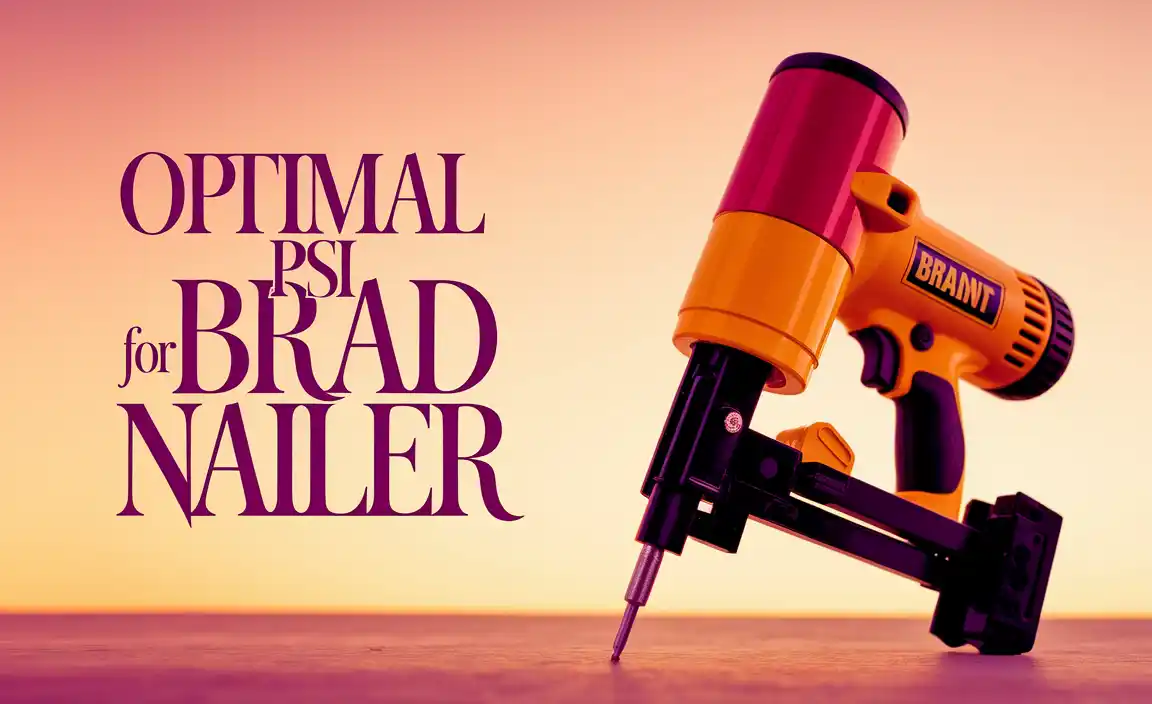Choosing the best framing nailer for heavy-duty work is straightforward when you understand key features like power source, nail collation, and depth adjustment. This guide simplifies the process, ensuring you pick a reliable tool for any construction project, big or small, with confidence.
Table of Contents
Hey there, fellow DIYer and woodworker! Jack Shaffer here from Nailerguy.
Ever stared at a pile of lumber and felt a little overwhelmed by the idea of building with it? Maybe you’re planning a deck, a shed, or even a small addition, and you know you’ll need some power behind your nails. That’s where a framing nailer comes in – it’s a true game-changer for any serious project. But with so many options out there, picking the right one can feel like a puzzle. Don’t worry, though! I’ve been there, and I’m here to break down exactly what you need to know to choose the best framing nailer for your needs. We’ll look at the different types, what to consider, and how to make sure you get a tool that’s powerful, reliable, and safe to use. Get ready to tackle those big projects with your new favorite tool!
Why a Framing Nailer is Your New Best Friend
Imagine building a sturdy fence, framing up a room in your house, or constructing a robust deck. Doing all that hammering by hand would take ages and leave your arms aching! A framing nailer is designed for exactly these kinds of tough jobs. It drives long nails quickly and powerfully, making construction tasks significantly faster and easier. It’s the kind of tool that makes you feel like a pro, even if you’re just starting out with bigger projects. Getting the right one means you’re set for countless DIY adventures.
Understanding the Different Types of Framing Nailers
Before we dive into choosing the best framing nailer, it’s helpful to know the main types available. This will help you narrow down what kind of power source and features will work best for your workspace and projects.
1. Pneumatic Framing Nailers
These are the workhorses of the construction world. Pneumatic nailers require an air compressor to operate.
How they work: They use compressed air to drive the nail. You’ll need an air compressor and an air hose to connect it to the nailer.
Pros:
Power: Generally the most powerful option, great for driving large nails through dense materials.
Durability: Often built for heavy-duty, continuous use.
Lightweight (tool itself): The tool itself is usually lighter than corded electric or battery-powered models because the motor and compressor are separate.
Cost-effective (tool): The nailer unit itself can sometimes be less expensive than equivalent cordless models.
Cons:
Dependency on Compressor: You need a compressor, which adds to the cost, noise, and requires a power source.
Hose Management: The air hose can get in the way and limit your mobility.
Setup Time: Hooking up the compressor and hose takes a little extra time.
2. Cordless Battery-Powered Framing Nailers
These have become incredibly popular for their portability and ease of use.
How they work: They use a rechargeable battery to power a motor that drives the nail. Some models also have a small gas cartridge for added power.
Pros:
Portability: No cords or air hoses! You can use them anywhere.
Ease of Use: Just grab and go. Great for quick jobs or working in tight spaces.
Fast Setup: No need to hook up air compressors.
Cons:
Weight: Can be heavier due to the battery pack.
Battery Life: You need to manage charged batteries. Longer projects might require spare batteries.
Power: While powerful, some may not match the raw driving power of high-end pneumatics for the absolute toughest materials or largest nails.
Cost: Often more expensive upfront due to the battery technology.
3. Corded Electric Framing Nailers
These plug directly into a wall outlet.
How they work: A powerful electric motor drives the nail.
Pros:
Consistent Power: No need to worry about battery life or air pressure.
Lighter than some battery models: No heavy battery pack.
Cons:
Limited Mobility: You’re tethered to an extension cord, which can be a hassle and a safety concern on large sites.
Not Ideal for Framing: Generally less powerful than pneumatic or cordless battery models. Most are better suited for lighter tasks like trim or paneling, rather than heavy-duty framing.
Can be bulky: The motor housing can make them a bit less ergonomic for some users.
For heavy-duty framing “chosen the best framing nailer for your needs,” you’ll almost certainly be looking at either pneumatic or cordless battery-powered models.
Key Features to Consider When Choosing Your Nailer
Now that you know the types, let’s talk about the features that really matter. Think of these as the checklist for finding a framing nailer that fits you perfectly.
1. Nail Collation Type
This refers to how the nails are held together in the magazine. It affects the angle of the magazine and how many nails you can load at once.
Strip Collated: Nails are held together in straight strips.
Paper Collated: The nails are glued together with paper. They are easy to load and the paper usually disintegrates or peels away from the workpiece. This is the most common type for framing nailers.
Plastic Collated: Nails have plastic heads that hold them together. These are generally tougher and don’t split as easily in wet conditions as paper collated nails, but the plastic might leave small marks or debris on the surface.
Coil Collated: Nails are held together in a coil, usually with wire or plastic. Coil collated nailers have a rounder magazine.
Pros: Coil nailers can often hold more nails than strip nailers, meaning fewer reloads on long jobs. They are also great for tight spaces because the magazine is more compact.
Cons: Coil nails can be a bit harder to find in certain sizes or types compared to strip nails. Sometimes, a nail from the coil might not drive cleanly, leaving a few extra behind.
For heavy-duty framing, paper-collated strip nailers are the most popular and generally offer the best balance of performance, availability, and ease of use.
2. Nail Size and Gauge
Framing nailers drive larger, thicker nails. The most common sizes are:
Length: Typically from 2 inches up to 3-1/2 inches.
Gauge: Refers to the thickness of the nail. Framing nailers use larger gauges (meaning thinner wires for the same nail diameter, a bit counterintuitive!). Common gauges are 7, 8, and 9 (e.g., a 3-1/2 inch 7-gauge nail is quite substantial).
Make sure the nailer you choose can accept the nail sizes and gauges required for your specific project. Most framing nailers are designed for 2″ to 3-1/2″ nails.
3. Firing Mode: Sequential vs. Contact (Bump) Fire
This is a crucial safety and speed feature, and most framing nailers offer bothselectable modes.
Sequential Fire (Single Shot): You must intentionally depress the safety contact tip against the wood and then pull the trigger for each nail to fire.
Pros: Offers the most control and precision. Essential for safety and accurate placement, especially when you don’t want to accidentally drive a nail where you didn’t intend.
Cons: Slower for rapid nailing.
Contact Fire (Bump Fire): You can engage the safety contact tip and then quickly “bump” it against the surface while holding the trigger down, firing nails rapidly.
Pros: Much faster for quickly driving multiple nails, like when assembling walls or laying floor joists.
Cons: Requires practice. It’s easier to accidentally overdrive nails or place them inaccurately if not careful. Always ensure you’re in a safe location to fire before engaging rapid fire.
Most professional framing nailers allow you to switch between these modes. Sequential is great for precision, while contact fire is excellent for speed. For framing, you’ll want the option to switch!
4. Depth Adjustment
This feature allows you to control how deep the nail is driven into the wood.
Why it’s important: You want nails to be flush or slightly countersunk, but not so deep that they lose holding power or damage the wood surface unnecessarily. Being able to adjust depth means you can dial it in for different wood types (hardwood vs. softwood) or when working with sheathing versus framing lumber.
How it works: Usually a dial or lever near the nose of the nailer.
Easy-to-use, tool-less depth adjustment is a big plus!
5. Magazine Capacity and Loading Ease
Capacity: How many nails can you load at once? Common capacities range from 50 to over 100 nails. More capacity means fewer interruptions.
Loading: How easy is it to load a new strip or coil of nails? A simple, well-designed loading mechanism can save you time and frustration.
6. Ergonomics and Weight
You’ll be holding this tool for extended periods.
Grip: A comfortable, non-slip grip is essential.
Balance: The weight distribution of the nailer matters.
Weight: Lighter is generally better, especially for cordless models, but don’t sacrifice power or durability for just a few ounces. Keep in mind that pneumatic tools have the weight of the tool itself, while cordless models have the added weight of the battery.
7. Dry Fire Lockout
This is a smart feature that prevents the nailer from firing when there are no nails left in the magazine. It saves wear and tear on the tool and prevents you from accidentally firing blanks.
Choosing the Best Framing Nailer Based on Your Projects
Let’s match nailer types and features to common DIY scenarios.
For the Weekend Warrior Building a Deck or Shed
Recommendation: A cordless battery-powered framing nailer is often the top choice here.
Why: The freedom from air hoses is a huge advantage for yard projects. You can move around easily without dragging hoses, and setup is instantaneous. Most modern cordless framing nailers pack plenty of power for these tasks.
Key Features to look for: Good battery life (consider getting a spare battery), selectable firing modes, and tool-less depth adjustment. Brands like DeWalt, Metabo HPT (formerly Hitachi), and Milwaukee offer excellent options.
For the Serious DIYer or Hobbyist Doing Home Renovations (Framing Walls, Joists)
Recommendation: Either a high-quality cordless or a reliable pneumatic framing nailer.
Why: If you already have a good air compressor, a pneumatic nailer might be more budget-friendly and offer immense power for continuous use. If portability and quick setup are paramount, a top-tier cordless model is still a fantastic choice.
Key Features: Robust construction, high magazine capacity, and both sequential and contact fire modes are really important. Check out brands known for durability like Bostitch, Paslode (for cordless pneumatic), or Senco.
For the Budget-Conscious Builder
Recommendation: A good quality pneumatic framing nailer is usually the most cost-effective route, provided you already have or plan to invest in a decent air compressor.
Why: The initial tool cost for a pneumatic framing nailer is often lower than comparable cordless battery models. While an air compressor is an additional investment, it’s a versatile tool that can power many other pneumatic tools.
Key Features: Look for well-reviewed models from reputable manufacturers like Porter-Cable or Craftsman for good value. Ensure it has the basic depth adjustment and selectable firing modes.
Important Considerations for Pneumatic Nailer Users
If you go the pneumatic route, there are a few extra things to keep in mind.
Air Compressor: You’ll need an air compressor with sufficient power (measured in CFM – Cubic Feet per Minute) and tank size to keep up with the nailer. A general rule of thumb is to get a compressor that outputs at least 2-3 CFM more than the nailer’s average consumption. For framing, a 25-gallon tank is a good starting point for most DIYers.
Air Hose: A good quality air hose (1/4-inch diameter is standard for most framing nailers) is essential. The length will determine your working radius.
Air Regulator and Lubricator: You’ll want an air regulator to set the proper air pressure for your nailer (usually between 70-120 PSI, check your tool’s manual). An inline lubricator can also help keep the tool running smoothly.
For more on setting up your air system, resources like Woodsmith’s guide on air compressors can be very helpful.
Essential Safety Gear and Practices
This is non-negotiable, folks! Using a framing nailer without proper safety gear is a recipe for disaster.
Safety Glasses: Always wear ANSI-Z87.1-rated safety glasses or goggles. A flying nail or nail fragment can cause serious eye injury.
Hearing Protection: Nail guns are loud! Use earplugs or earmuffs to protect your hearing.
Gloves: Work gloves can protect your hands from splinters and provide a better grip.
Sturdy Footwear: Protect your feet from dropped materials or tools.
Understand Your Tool: Read the owner’s manual! Know how your specific nailer operates, especially its safety features and firing modes.
Never Point at Anyone: Treat the nailer like a firearm. Never point it at yourself or others, loaded or unloaded.
Keep Fingers Off the Trigger When Not Nailing: Only place your finger on the trigger when you are actively intending to drive a nail.
Engage Safety Tips Properly: Make sure the safety contact tip is pressed flush against the workpiece before firing.
Be Aware of Your Surroundings: Ensure there’s nothing behind your workpiece that a nail could pass through.
The Occupational Safety and Health Administration (OSHA’s Nail Gun Safety page) has excellent resources on safe nail gun operation.
Maintenance for Longevity
A little care goes a long way in keeping your framing nailer working efficiently.
Clean It Regularly: Wipe down the exterior and especially the nose of the nailer after use.
Lubricate (Pneumatic): If you have an inline lubricator, use oil recommended by the manufacturer. If not, apply a few drops directly into the air inlet occasionally as per the manual.
Check for Damage: Periodically inspect hoses (for pneumatic), the magazine, and the overall tool for any cracks or wear.
Store Properly: Keep your nailer in a clean, dry place, away from extreme temperatures.
Making Your Final Decision: A Quick Comparison
To help solidify your choice, let’s look at a simplified comparison.
| Feature | Pneumatic Framing Nailer | Cordless Battery Framing Nailer |
|---|---|---|
| Power Source | Air Compressor & Hose | Rechargeable Battery (sometimes gas assist) |
| Portability | Limited by hose length | Excellent, works anywhere |
| Initial Cost (Tool Only) | Generally Lower | Generally Higher |
| Setup Time | Moderate (compressor hookup) | Instant |
| Weight of Tool | Lighter tool, but requires compressor | Heavier tool (due to battery) |
| Best For | Workshops, stationary projects, budget-conscious | On-site jobs, mobile work, convenience |
The “best” framing nailer truly depends on your personal circumstances, the types of jobs you do most often, and your budget. Don’t be afraid to try holding different models in a store if possible to get a feel for their weight and balance.
FAQ: Your Top Framing Nailer Questions Answered
Q: What size nails do framing nailers use?
A: Framing nailers use long nails, typically ranging from 2 inches to 3-1/2 inches in length. They also use larger gauge nails which means they are thicker and stronger for structural work.
Q: Can I use a framing nailer for lighter projects like trim work?
A: While it’s technically possible, a framing nailer is overkill for trim. It will likely drive nails too deep and cause excessive damage. Trim nailers are designed for much smaller, finer brad or finish nails and are better suited for those jobs.
*
Q: How much air pressure do I need for a pneumatic framing nailer?
A: Most framing nailers operate between 70 and 120 PSI (pounds per square



